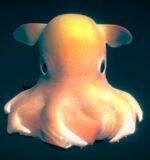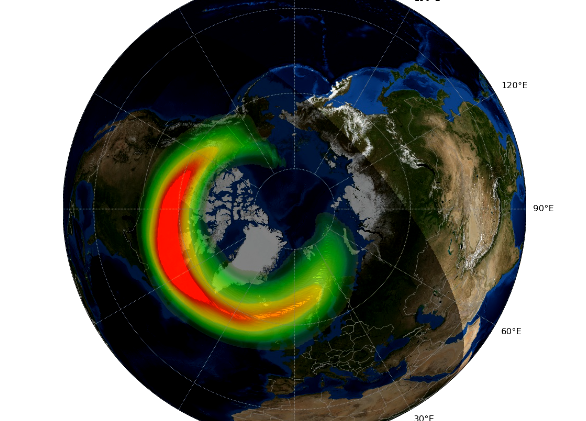Its resemblance to the main character in a 1941 Disney movie has given this fascinating genus of ocean animals its name.
The life of these fascinating creatures, however, is far less enjoyable than that of the fictional character they were named for.
Let’s take a closer look at some of the most interesting facts about the Dumbo Octopus, one of the many marine animals that float around in the deep sea.
1. It’s a genus in the group of umbrella octopuses
Grimpoteuthis is the scientific name of a genus of octopuses commonly referred to as the Dumbo Octopus. This genus is part of the umbrella octopuses of the Opisthoteuthidae.
These deepsea creatures are so-called pelagic octopuses, meaning they live at extreme depths in the vast open oceans of the world.
Umbrella octopuses are named as such because they feature a web of skin between their tentacles which allows them to cover themselves as if it was an umbrella.

2. There are 17 different species in the genus Grimpoteuthis
The genus Grimpoteuthis features a total of 17 recognized species. These are the following:
- Grimpoteuthis abyssicola
- Grimpoteuthis angularis
- Grimpoteuthis bathynectes
- Grimpoteuthis boylei
- Grimpoteuthis challengeri
- Grimpoteuthis discoveryi
- Grimpoteuthis greeni
- Grimpoteuthis hippocrepium
- Grimpoteuthis imperator
- Grimpoteuthis innominata
- Grimpoteuthis meangensis
- Grimpoteuthis megaptera
- Grimpoteuthis pacifica
- Grimpoteuthis plena
- Grimpoteuthis tuftsi
- Grimpoteuthis umbellata
- Grimpoteuthis wuelkeri
3. Several species have been shuffled around different genera
What’s fascinating about several species in the genus Grimpoteuthis is that there are several of them which are only known by a couple of specimens.
Only two specimens of the Grimpoteuthis abyssicola and only three specimens of the Grimpoteuthis greeni have ever been found.
The Grimpoteuthis angularis is only known from a single specimen that was discovered off the coast of New Zealand in 2022.
As you surely expected, this makes it pretty hard to identify these creatures and place them in the correct genus.
Several species discovered during the Challenger Expedition in the 19th century were placed in either the genus Cirroteuthis or the genus Stauroteuthis.
It’s only fairly recently that they were assigned to the genus Grimpoteuthis. The confusion won’t go away any time soon because a new family called the Grimpoteuthididae has been proposed.

4. Their fins are what makes them resemble the Disney character
The most distinctive features of this type of octopus are the fins that extend from an area just above their eyes.
They can use these to slowly swim in the depths of the ocean. As you can see, this feature strikingly resembles the ears of the Disney character Dumbo.
Similar to the elephant in the 1941 animated movie produced by Walt Disney Productions, the Dumbo Octopus appears to be using these fins to float around.
5. Where do Dumbo Octopuses live?
Being referred to as Pelagic animals doesn’t tell us much about where these creatures live. The pelagic zone is divided into many different regions based on depth.
The Dumpbo Octopus can be found on the abyssal plains of the ocean floor. They live at depths of anywhere between 1,000 and 7,000 meters (3,280 and 22,965 feet).
They don’t seem to be bound to a specific region as well because they have been found in various parts of the world’s oceans, including off the coasts of:
- Oregon
- the Philippines
- Martha’s Vineyard
- the Azores
- New Zealand
- Australia
- California
- Gulf of Mexico
- Papua and New Guinea

6. They have several predators despite the extreme depth where they live
The world in which the members of the genus Grimpoteuthis live is a cold, dark, and unforgiving one. It’s quite a big contrast to the jolly world of the Disney character that they were named after.
One of the most interesting dumbo octopus facts is that they are the deepest living octopuses that have ever been discovered.
The deepest they have ever been found was in 2020 near the Java Trench off the coast of Sumatra Indonesia. One individual was roaming around at a depth of 6,957 meters (22,824 feet).
One of the reasons why they are living at such depths is to avoid the abundance of predators who see them as a great meal.
Their biggest fear is either large teleost fish or several species of sharks such as Goblin Sharks that actively hunt them.
7. These creatures roam around the ocean floor and contract when provoked
Whenever a member of the genus Grimpoteuthis has been observed in the deep ocean, they appear to be roaming around on the ocean floor.
They do, however, feature a defense mechanism that allows them to jump from the floor and swim away using their fins. This is, however, surely not enough to avoid predators.
What’s fascinating is that they don’t have an inc sac to scare away predators or the ability to change color to camouflage themselves. How they manage to avoid being caught rather easily remains a mystery.

8. Little is known about the feeding behavior of the Dumbo Octopus
There have been zero sightings of a dumbo octopus catching prey and feeding on smaller creatures that cross their paths.
We do, however, know from the contents of their stomachs that they largely feed on small crustaceans, bivalves, worms, and copepods.
They likely employ the relatively simple technique used by members of the genus Opisthoteuthis, also known as flapjack octopuses.
Although this is speculation, if that’s the case they simply trap the prey into the webbing between their tentacles and use their tentacles to bring the food to their mouths.

9. Male and female octopuses in this genus look about the same
The size of these types of octopuses differs quite a bit among species. While there are species that only have a length of 5 centimeters (1.96 inches), there are also much larger species that reach a length of up to 37 centimeters (14.56 inches).
While many types of octopuses feature noticeable sexual dimorphism, this is not the case with dumbo octopuses. Male and females are generally similar in size.
The only noticeable difference between males and females has been found in both the Grimpoteuthis bathynectes and the Grimpoteuthis discovery in which males have larger suckers on the tentacles.
10. There are two remarkable aspects of Grimpoteuthis breeding
These octopuses have been described as “continuous spawners.” This means that there is no specific breeding period and females continue to lay one or two eggs at a time.
There are two remarkable aspects of their breeding cycle:
- The eggs of the members of the Grimpoteuthis feature a hard casing unseen in other types of octopuses. Because of this, females don’t incubate or even stay with the eggs.
- The males don’t have a hectocotylus, the tentacle-like organ that transfers the sperm. How exactly they breed remains a mystery until today.
When juveniles emerge from the eggs, they are pretty much capable of doing whatever adult specimens do, fully grown and ready to roam around on the ocean floor themselves.









 Photographer Finds Locations Of 1960s Postcards To See How They Look Today, And The Difference Is Unbelievable
Photographer Finds Locations Of 1960s Postcards To See How They Look Today, And The Difference Is Unbelievable  Hij zet 3 IKEA kastjes tegen elkaar aan en maakt dit voor zijn vrouw…Wat een gaaf resultaat!!
Hij zet 3 IKEA kastjes tegen elkaar aan en maakt dit voor zijn vrouw…Wat een gaaf resultaat!!  Scientists Discover 512-Year-Old Shark, Which Would Be The Oldest Living Vertebrate On The Planet
Scientists Discover 512-Year-Old Shark, Which Would Be The Oldest Living Vertebrate On The Planet  Hus til salg er kun 22 kvadratmeter – men vent til du ser det indvendigt
Hus til salg er kun 22 kvadratmeter – men vent til du ser det indvendigt  Superknepet – så blir snuskiga ugnsformen som ny igen!
Superknepet – så blir snuskiga ugnsformen som ny igen!  Meteorite That Recently Fell in Somalia Turns Out to Contain Two Minerals Never Before Seen on Earth
Meteorite That Recently Fell in Somalia Turns Out to Contain Two Minerals Never Before Seen on Earth  Nearly Frozen Waves Captured On Camera By Nantucket Photographer
Nearly Frozen Waves Captured On Camera By Nantucket Photographer  It’s Official: Astronomers Have Discovered another Earth
It’s Official: Astronomers Have Discovered another Earth 